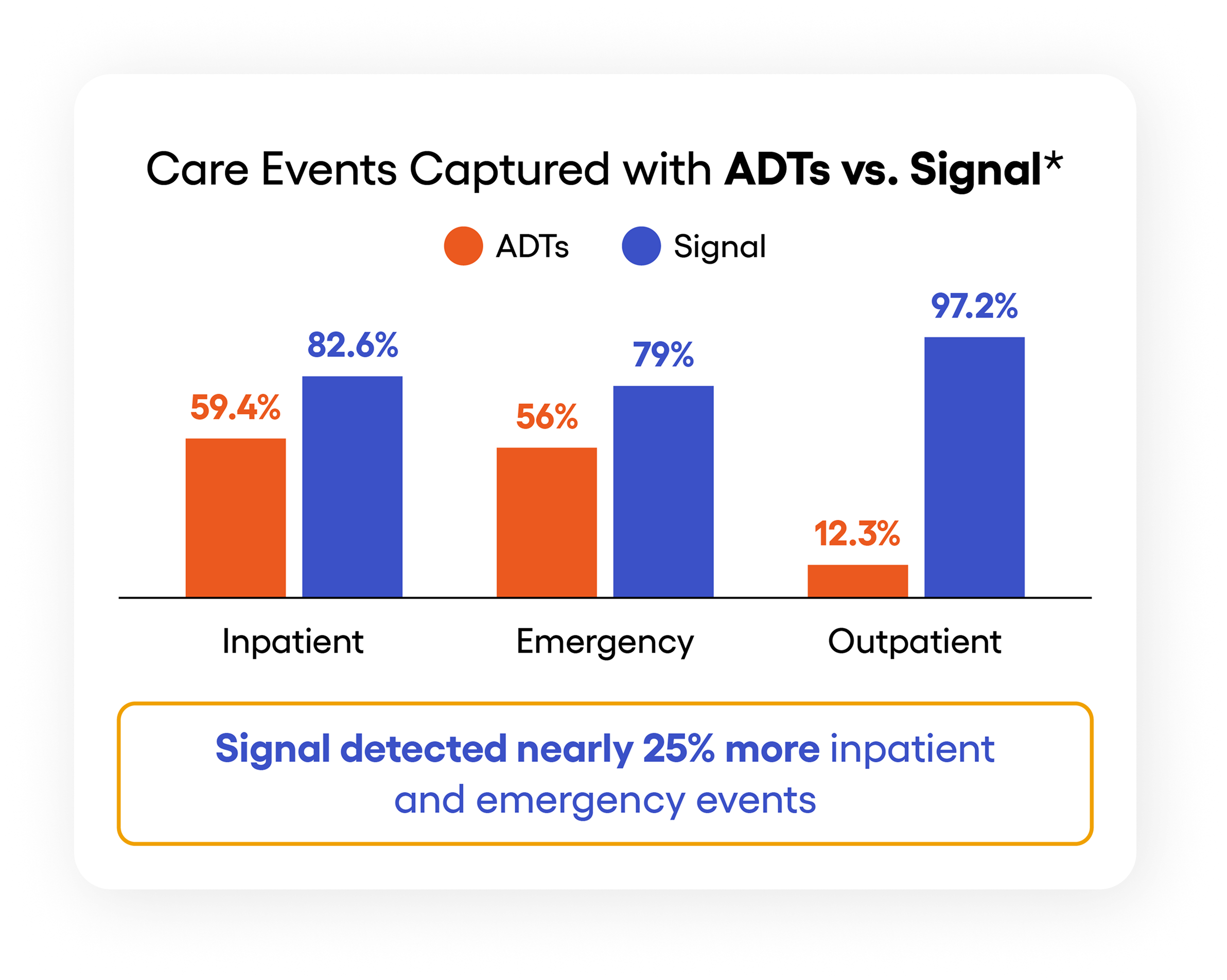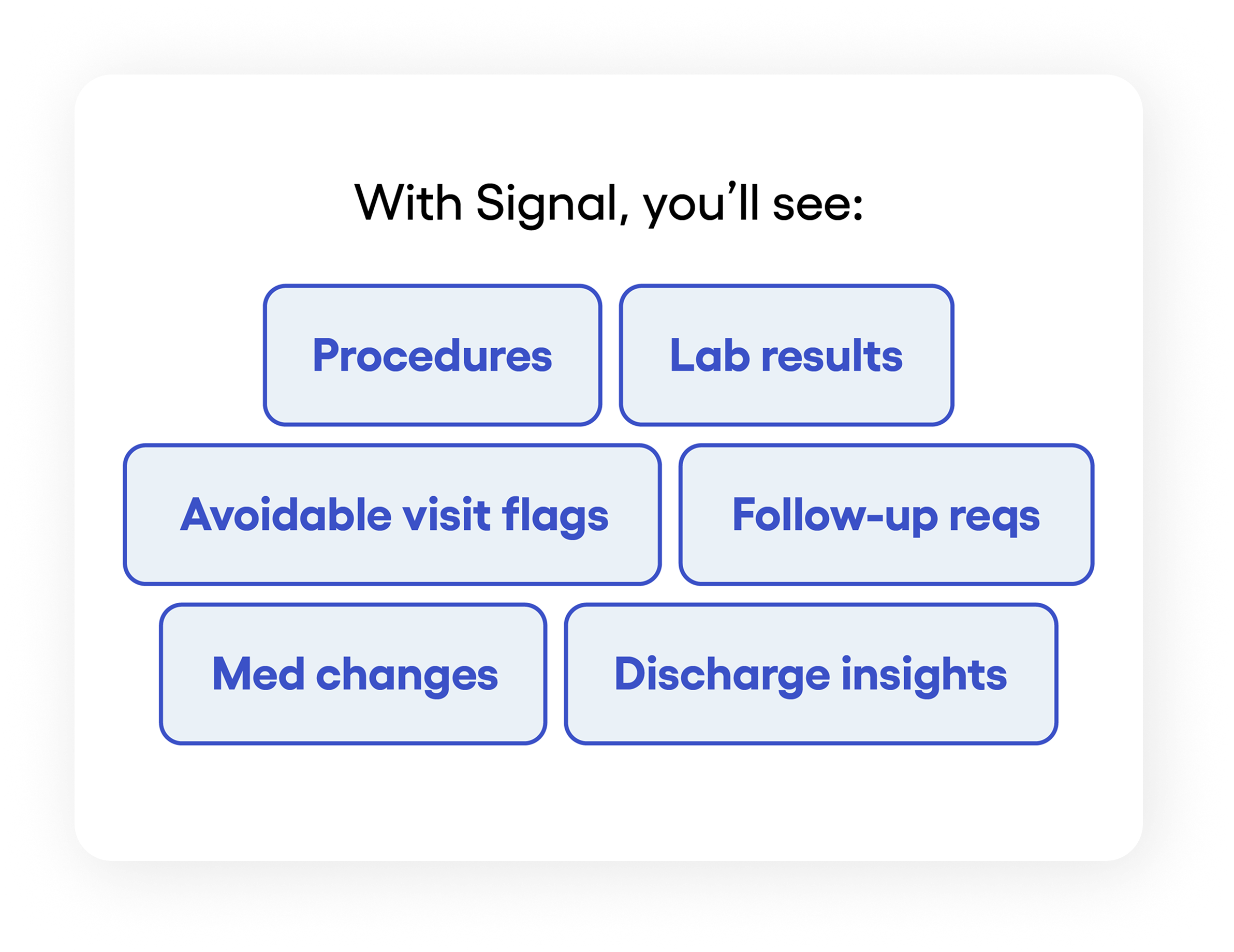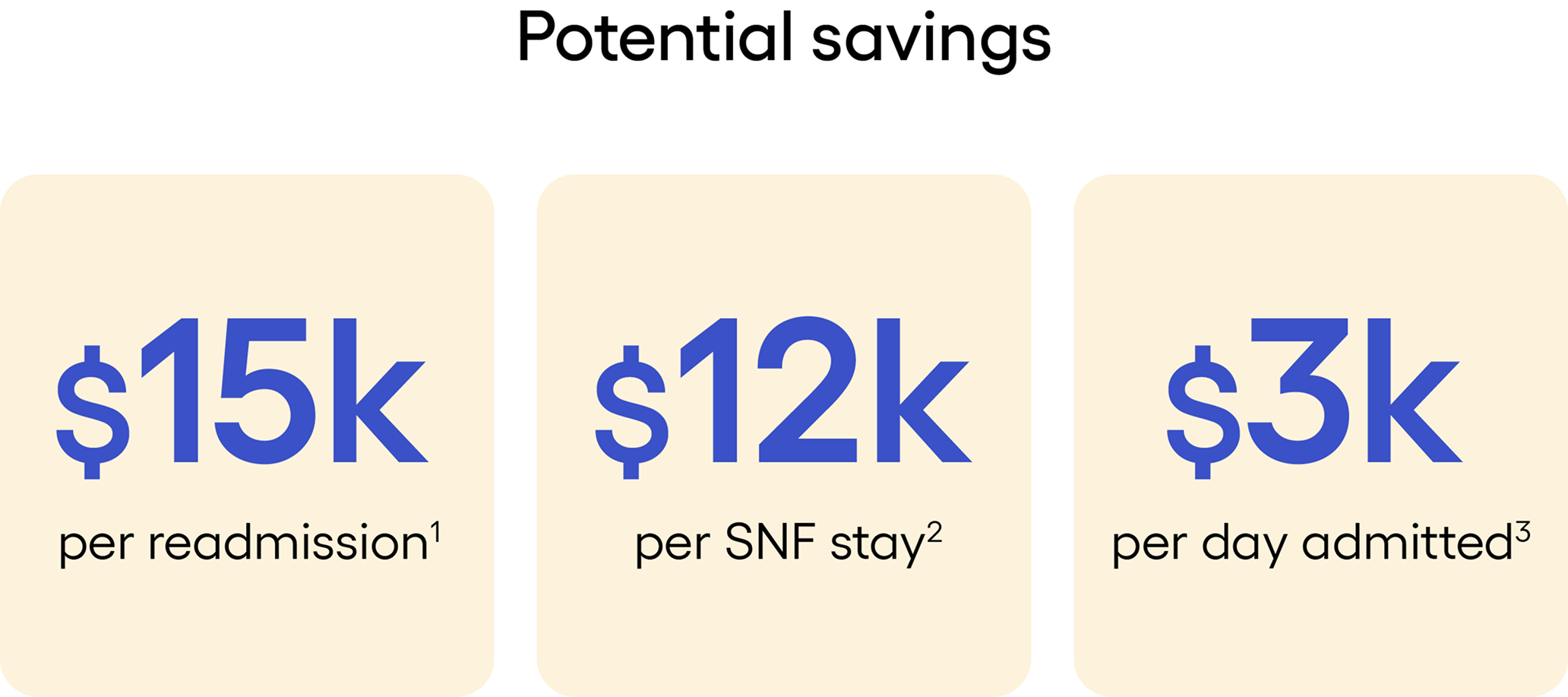
Power transitions of care with Signal alerts
Nationwide Signal alerts surface the clinical context care teams need to act fast, improve patient health and reduce costs.

ADTs lack all the coverage and context care teams need.
Admission, discharge and transfer (ADT) feeds are supposed to help clinicians optimize transitional care during critical health events. But when these events occur outside the ADT network — and because the alerts lack clinical context — care teams are left in the dark.
See more, know more and do more with Signal alerts.
Signal delivers the near-real-time, nationwide alerts — including key clinical context — that care teams need to improve transitional care. The results? Fewer costly hospital readmissions, shorter hospital length-of-stay and reduced unnecessary post-acute care.
What you can do with Particle Signal
Signal FAQ
Particle Health’s Signal offering is an intelligent alerting solution that delivers timely, actionable insights into critical patient events.
Signal alerts enable organizations to shift from reactive to proactive care, surfacing the right information at the right time to improve transitions of care, enhance patient outcomes, and reduce costs.
First, customers enroll their patient populations with Particle Health. Signal then continuously monitors national health information networks as well as participating state and regional health information exchanges (HIEs) for significant acute or post-acute events (such as hospital admissions, discharges or transfers) that occur within those populations.
When triggering events occur, Signal pushes targeted, context-rich alerts to care teams. These alerts empower swift, informed intervention and help care teams meaningfully engage patients and caregivers during vulnerable moments across healthcare settings.
Signal insights also surface other clinical moments along a patient's journey — including new prescriptions, changes in medication adherence, lab results and new diagnoses — equipping care teams with the alert that an event has happened as well as the context they need to provide timely, comprehensive care.
In comparison to traditional admission, discharge, and transfer (ADT) feeds, Signal delivers broader coverage and richer context for stronger actionability.
- Broader coverage: Instead of piecing together fragmented ADT feeds for partial coverage, you can rely on Signal to provide alerts through a single, comprehensive solution, built on national networks, HIEs and pharmacy alerts.
- Signal provides nationwide coverage across 90% of Centers for Medicare & Medicaid Services (CMS) certified hospitals and extensive post acute facilities.
- In a direct comparison for a VBC provider using 6+ ADT feeds — including an aggregator and multiple state HIEs — Signal identified nearly 25% more inpatient and emergency events than standard ADTs.
- Richer context: In addition to capturing events that standard ADTs may miss, Signal alerts also provide contextual information most don't include at all. ADTs confirm something happened, but Signal provides the full story.
- Stronger actionability: Signal ensures the right clinical information is delivered for the right patient at the moment it can impact care. And with 75% of discharges identified within 48 hours, Signal empowers care teams to intervene faster and optimize critical transitions of care.
Signal monitors major national health information networks including Carequality, CommonWell Health Alliance and eHealth Exchange, as well as State and regional Health Information Exchanges (HIEs), and pharmacy alerts.
These networks connect to approximately 90% of U.S. EHRs, and Particle has seen data from 90% of active CMS hospitals, demonstrating extensive coverage across healthcare organizations. As a result of this breadth, Signal is especially powerful for organizations treating national populations.
Signal goes beyond basic ADT alerts, providing near real-time access to structured clinical details that explain what actually happened including:
- Discharge summaries
- Procedures
- Lab results
- Medication changes
- Recommended follow ups
- Readmission risk flags
- And other key info to help optimize transitions of care
With Signal, teams get a more complete view of the patient’s clinical status in acute and post-acute settings, empowering them to effectively identify follow-up needs, reconcile medications, develop comprehensive post-discharge care plans and more.
With Signal, organizations can optimize transitions of care to improve patient health while lowering total cost of care and improving performance on key quality measures. Signal achieves these goals by enabling care teams to reduce readmissions, shorten length of stay, optimize site of care, and close gaps in care.
Signal improves patient outcomes by surfacing critical events. Each alert is delivered with the clinical context that care teams need to take timely action for informed follow-up and streamlined care coordination.
Signal can also be leveraged at moments of acute or post-acute care for enrollment in programs to manage or prevent chronic conditions. Centered on the patient, Signal empowers more proactive patient and caregiver engagement, anticipatory guidance, and support during vulnerable moments that matter.
Signal alerts are designed to fit into your workflows through a single API. The output has been designed for straightforward integration into care coordination platforms and downstream processes. This ensures care teams have the information they need without disrupting existing clinical workflows.
A solution built for:
Value-based care
From patient clinical risk assessment, to care optimization, to accurate outcomes reporting — we’ve got you covered.
Payers
Optimize patient clinical health, improve STAR/HEDIS measures and understand your population with insights from Particle.
Learn more about Signal
Ready to get started?











